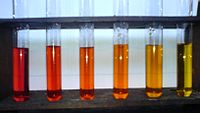- Methyl orange
-
Methyl orange 

 4-dimethylaminoazobenzene-4'-sulfonic acid sodium saltOther namesp-dimethylamino-azobenzenesulfonic acid
4-dimethylaminoazobenzene-4'-sulfonic acid sodium saltOther namesp-dimethylamino-azobenzenesulfonic acidIdentifiers CAS number 547-58-0 
ChemSpider 16736152 
Jmol-3D images Image 1 - [Na+].CN(C)c2ccc(/N=N/c1ccc(cc1)S([O-])(=O)=O)cc2
- InChI=1S/C14H15N3O3S.Na/c1-17(2)13-7-3-11(4-8-13)15-16-12-5-9-14(10-6-12)21(18,19)20;/h3-10H,1-2H3,(H,18,19,20);/q;+1/p-1

Key: STZCRXQWRGQSJD-UHFFFAOYSA-M
InChI=1/C14H15N3O3S.Na/c1-17(2)13-7-3-11(4-8-13)15-16-12-5-9-14(10-6-12)21(18,19)20;/h3-10H,1-2H3,(H,18,19,20);/q;+1/p-1
Key: STZCRXQWRGQSJD-REWHXWOFAG
Properties Molecular formula C14H14N3NaO3S Molar mass 327.33 g/mol Density 1.28 g/cm3, solid Melting point >300 °C (Not precisely defined.)
Boiling point Decomposes.
Solubility in water Soluble in hot water  orange (verify) (what is:
orange (verify) (what is:  /
/ ?)
?)
Except where noted otherwise, data are given for materials in their standard state (at 25 °C, 100 kPa)Infobox references Methyl orange is a pH indicator frequently used in titrations.
It is often used in titrations because of its clear and distinct colour change. Because it changes colour at the pH of a mid-strength acid, it is usually used in titrations for acids. Unlike a universal indicator, methyl orange does not have a full spectrum of colour change, but has a sharper end point.
Methyl orange has mutagenic properties[1].
Contents
Indicator colours
Methyl orange (pH indicator) below pH 3.1 above pH 4.4 3.1 ↔ 4.4 Methyl orange in xylene cyanol solution (pH indicator) below pH 3.2 above pH 4.2 3.2 ↔ 4.2 In a solution becoming less acidic, methyl orange moves from red to orange and finally to yellow with the reverse occurring for a solution increasing in acidity. The entire colour change occurs in acidic conditions.
In an acid it is reddish and in alkali it is yellow. Methyl orange has a pKa of 3.47 in water at 25 degrees Celsius.[2]
Other Indicators
- Modified (or screened) methyl orange, an indicator consisting of a solution of methyl orange and xylene cyanol, changes from grey to green as the solution becomes more basic.
- A number of other common indicators are tabulated in the article on pH indicators.
See also
References
- ^ MSDS from ScienceLab.com, Inc. Retrieved 2011-09-24
- ^ Sandberg, Richard G.; Henderson, Gary H.; White, Robert D.; Eyring, Edward M. (1972). "Kinetics of acid dissociation-ion recombination of aqueous methyl orange". The Journal of Physical Chemistry 76 (26): 4023–4025. doi:10.1021/j100670a024.
External links
Categories:- PH indicators
- Azo dyes
- Benzenesulfonates
- Anilines
- Sodium compounds
Wikimedia Foundation. 2010.

